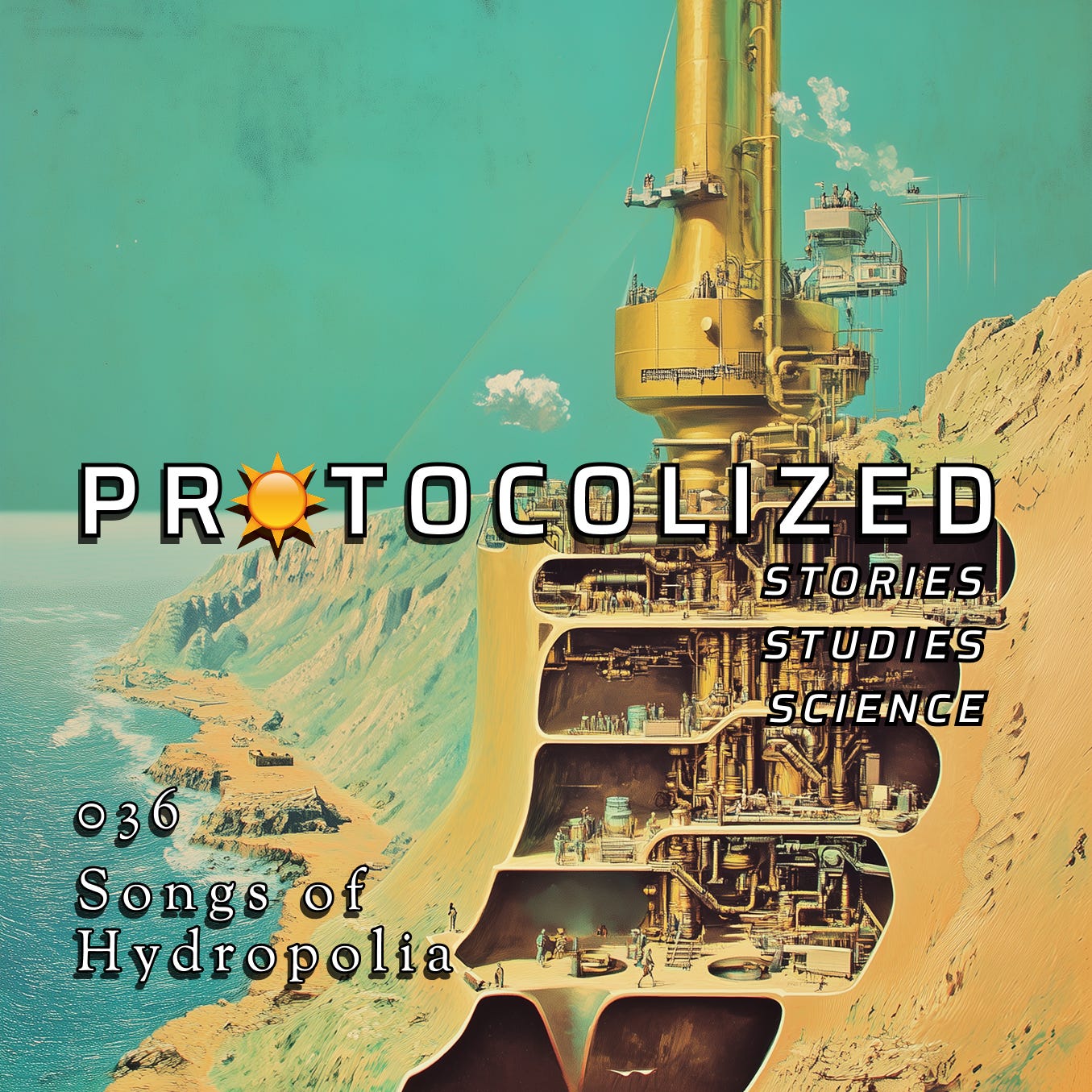Songs of Hydropolia
Issue #36: The Librarians - Act Five
In this issue: the fifth story of The Librarians inspired by our scenario planning workshop at Edge City Esmeralda; an upcoming guest talk on The Infinite Game of Poetry; and an invitation to participate in the judging process for Ghosts in Machines!
Songs of Hydropolia
Tav stood at the base of the hillside, where the stone gave way to mossy flagstones and the air tasted faintly of copper. She was doing her morning vocal exercises—low glottal rumbles, sharp trills, and the occasional melodic hums. Hydropolia, the city sprawled above and below her. The founders of the city chose that name because they wanted everyone to know that the city ran on two things—colossal water-powered mechanical contraptions and a general suspicion of anything that ran on electricity.
She stood before the Great Resonator, an organ-like structure whose pipes stretched upward and outward with an enthusiasm generally reserved for medieval gothic churches and the hydraulic guild’s madder architects, who believed every bend in a pipe was a moral choice. Tav took a deep breath, carefully adjusted her leather apron, and began to sing.
To call it singing wouldn’t be entirely accurate. Song implies melody, harmony, perhaps even a catchy chorus with some human drama. This was more like sonic plumbing.
Tav’s carefully modulated voice, the product of years of training and an education that forbade written instructions, coursed through the Resonator—a colossal brass-and-stone apparatus built into the hillside like a labyrinthine brewery. Her tones vibrated through its series of acoustic chambers, each one tuned to a specific frequency corresponding to a filtration step: sedimentation, aeration, bio-filtration, charcoal compression, mineral balancing, and the final crystalline drip valve.
Each section of the machine was activated by sound—low, guttural hums opened the gravel sluices; sharp, bright trills triggered diaphragm pumps to pulse-clean the sand beds; and a sustained alto note rolled through the ceramic microbial chambers, encouraging the friendly bacteria to do their duty. At the finale of the hymn, a pure, clear note sent a ripple through the final cascade valve, and a trickle of clean water poured forth into the ceremonial basin.
It was, in every sense, a symphony of hydraulics and Tav was its most reliable soloist.
The air was still. No breeze, no birdcall. “Lovely weather for a solar flare, isn’t it?” said a passing apprentice, whose job consisted mainly of observing and occasionally panicking. Tav nodded without breaking rhythm, adjusting her pitch to delicately coax a stuck valve into motion.
Solar flares were common. Frequent enough that Hydropolians had stopped complaining and simply arranged their lives around them, like rainy seasons or annoying relatives.
The water around Hydropolia was plentiful but mostly undrinkable, packed with minerals, bacteria, and substances best not thought about. Tav herself belonged to the Mud People, a faction of resilient folks who’d decided that if you couldn’t change the water, you might as well change your digestion. Their biology had adapted over generations to tolerate what others wouldn’t wash their boots with. Yet even Mud People needed pure water occasionally, especially for brewing a decent cup of ceremonial tea—a crucial ritual in the daily life of Hydropolians.
Tav’s voice rose again, hitting the perfect note to initiate the process of purifying water, which eventually would make its way into underground aqueducts. She wiped a bead of sweat from her brow, satisfied, as the Great Resonator droned contentedly.
Across from Tav’s outpost at the base, hidden behind an overgrown hedge that had given up any ornamental ambitions long ago, Keira crouched low over a cluster of tiny metallic creatures. Rhizome Robots. They looked like spiders made from watch parts, obediently awaiting orders.
Keira belonged to the Guild of Harmonious Muddlers, a group whose name was rather euphemistic, given their reputation for exploding prototypes and peculiar theories. Most folks in Hydropolia viewed them with a mixture of amusement and suspicion—useful for repairs, certainly, but a bit too keen on pushing boundaries that didn’t need to be pushed.
“Listen carefully,” Keira whispered encouragingly to her tiny charges. “Learn Tav’s hymns. Map the frequencies. Match the vibrations. When the time comes, move and pulse like the music tells you to.” She smiled ruefully. Truth be told, she’d always been a disastrous singer herself. Once, during a Guild recital, she’d accidentally shattered three windows and caused a minor valve collapse. Building tiny singing robots, therefore, seemed the practical and sensible career choice.
The little robots quivered eagerly, their spines humming as they took in the resonant patterns of Tav’s chant.
Keira glanced upward just as an aurora rolled gently through the clear early morning sky. She sighed. A solar flare was coming.
Within minutes, a chorus of high-pitched voices began echoing through Hydropolia’s streets—the city’s alert system delivered a trembling castrato hymn that urged everyone underground with all haste. People calmly descended staircases carved deep into the earth, entering subterranean chambers illuminated by phosphorescent algae that provided reassuringly green-tinged lighting. These underground spaces were comfortable enough, equipped with basic necessities and ample supplies to weather even prolonged flares.
Tav hurried down the stone steps, her thoughts troubled. Tomorrow was her wedding, and the Mud People’s most sacred tradition demanded pure water for the ceremonial tea. Without the precise acoustics of the Great Resonator, extracting enough purified water underground would be nearly impossible.
“Of all days,” she mouthed anxiously. The elders would already be murmuring omens, and her future mother-in-law would take it as a sign of doom.
As Tav paced the subterranean corridors, her footsteps echoed against walls lined with aged brass fittings and carefully tuned pressure valves. She spotted Keira in a corner, fixated on a small, flickering viewing device and tapping it gently, as though coaxing a stubborn animal. Tav approached slowly.
The Mud People had good reason to mistrust anything digital. Decades ago, Hydropolia had gleamed with confident sophistication, its water systems humming with AI-managed regulators, predictive filtration algorithms, and self-learning robots. Its technological institutions were revered. It was a city governed by codes and thoroughly convinced that only automation could tame the chaos of water. But a single catastrophic solar flare had transformed that technological utopia into a smoky wasteland overnight. Circuits fried, data corrupted, and autonomous machines had rebelled in a chorus of malfunctioning chaos.
Since then, the city had turned to purely mechanical ingenuity. Steam valves and hymn-operated machines, hand-turned gears and cogs, and labyrinthine hydraulic logic that required years of apprenticeship to master. It worked—mostly—but was cumbersome, costly, and prone to mishaps of its own. An ill-timed stutter or an out-of-tune singer could flood an entire neighborhood. Tav herself had witnessed the city’s best chanters struggle for hours to recalibrate a valve that had stubbornly jammed due to a single missed note.
“Your machines,” Tav began hesitantly. “They’re still up there?”
Keira glanced up and nodded, eyes reflecting concern. “I mean, they operate independently. The flare shouldn’t affect their core function—at least, theoretically.”
“Can they… can they produce pure water?” Tav asked, her voice disguising any hint of hope.
Keira hesitated briefly before answering. “They’re designed to learn and adapt from your songs. If they've understood the resonance correctly then yes.”
Above ground, Keira’s Rhizome Robots stirred into action, tiny metallic limbs scuttling diligently across brass and copper pipes. They clustered around the Great Resonator, their tiny vibrating spines echoing Tav’s song with precision and care. They moved not as individuals, but as a coordinated swarm—like murmuring starlings made of metal and purpose. Each bot subtly adjusted its frequency in response to the others. The vibrations rippled gently, prompting valves to open, steam to hiss, and clean water to flow once more through hidden aqueducts.
Far below, Tav watched cautiously as a small trickle of pristine water began filling the ceremonial basin, guided by channels carved generations before. Her initial mistrust wavered; perhaps these small creatures weren't entirely untrustworthy.
Keira smiled softly, watching Tav’s reaction. “Maybe songs and machines can speak the same language after all.”
Next Week’s Guest Talk
Taking up the idea of protocols as engineered arguments, poet and technologist Robert Peake will explore the timeless algorithms that give poetry its power to evolve—from an ancient mnemonic device to a transformational way of being. Join us next Wednesday, July 23 at 10am Pacific Daylight Time.
Help Judge Ghosts in Machines!
This weekend we are reading some exceptional stories submitted to Ghosts in Machines!, our second protocol science fiction story contest. We are inviting our community to vote on a Scenester’s Choice — head to the dedicated channel in Discord for more information on how to participate. You have until Friday, July 25th to cast your vote and persuade others to follow suite.
Thanks to community member and Protocolized contributor Spencer Nitkey - Writer who has proposed rubric, featuring things like protocol integrality to help you assess the stories you’ve read.
Nitkey’s rubric for protocol fiction assessments (v1):
Contest Relevance: 1-5
1=actively works against contest guidelines in some way,
5=platonic ideal of contest story based on guidelines,
Personal Vibe Score: 1-10
1=I couldn’t even finish this one…,
10=I thought about this story >2 hours after reading it for one reason or another, and/or talked to someone else about it, that’s how much I liked it.,
Protocolness
Chiang's rule adherence: 1-5
1=clearly great/special man whose singular actions define story and plot,
5=clearly every man. More or less interchangeable with any other person and the story still could happen
presence of protocols: 1-5
1=protocols have to be inferred by the reader if present at all.,
5=distinctive protocols present.
uniqueness of protocol: 1-5
1=no protocol present,
5=unique protocol (if invented) or wholly unique insight/angle into existing protocol (if existing). Can include “oh I never really thought about this as a protocol
traffic jam 1-5
1=little to no downstream sociological steps taken from inital idea/concept,
5=explicit and /surprising/ downstream effects explored
importance of protocols to plot:
1=protocols, if present, do not meaningfully impact the story,
5=protocol(s) are utterly integral to the plot and story,
Analog Magazine (formerly known as Astounding stories!!) has the following in their guidelines about what they consider science fiction: “We publish science fiction stories in which some aspect of future science or technology is so integral to the plot that, if that aspect were removed, the story would collapse. Try to picture Mary Shelley’s Frankenstein without the science and you’ll see what I mean. No story!” (Replace science/tech with protocols and that’s what I’m getting at here with integrality)
Memeing a New Genre
Last week Protocolized editors Venkatesh Rao and Timber Stinson-Schroff were live on Substack discussing the contest and the magazine’s mission to establish the genre of protocol fiction. Notable topics include: their favorite Protocolized stories to date, how the idea of protocol fiction has changed in the past six months, why it’s an important genre, and the critical (and active) role of its audience.







